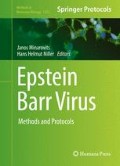Abstract
To interpret the results of an epigenetic analysis in gene expression studies, it is essential to characterize the activity of the relevant promoters. According to the literature, real-time PCR assay is the most widely used method for the determination of latent EBV promoter usage. Here we describe two alternative approaches to measure the activity of viral promoters in cell lines carrying latent EBV episomes. The widespread typical approach relies on total cellular RNA isolation, whereas the nuclear run-on assay described here is based on the initial isolation of nuclei, followed by in vitro transcription in the presence of biotinylated-UTP, and purification of RNA transcripts using avidin-coated magnetic beads. Finally, both methods apply reverse transcription-based real-time PCR (i.e., quantitative polymerase chain reaction, qPCR) to quantitatively measure the amount of specific transcripts. We shall describe these methods step by step and demonstrate their use for the determination of EBER1 promoter activity in EBV-positive cell lines.
Access this chapter
Tax calculation will be finalised at checkout
Purchases are for personal use only
References
Niller HH, Szenthe K, Minarovits J (2014) Epstein-Barr virus-host cell interactions: an epigenetic dialog? Front Genet 5:367
Manet E, Chevallier A, Zhang CX et al (1985) Construction and use of cDNA clones for the mapping and identification of Epstein-Barr virus early P3HR-1 mRNAs. J Virol 54:608–614
Pfaffl MW (2004) Quantification strategies in real-time PCR. In: Bustin SA (ed) A-Z of quantitative PCR. International University Line, La Jolla, pp 87–112
Gattei V, Degan M, De Iuliis A et al (1997) Competitive reverse-transcriptase PCR: a useful alternative to northern blotting for quantitative estimation of relative abundances of specific mRNAs in precious samples. Biochem J 325:565–567
Murphy D (1993) Nuclear run-on analysis of transcription. Methods Mol Biol 18:355–361
Patrone G, Puppo F, Cusano R et al (2000) Nuclear run-on assay using biotin labeling, magnetic bead capture and analysis by fluorescence-based RT-PCR. BioTechniques 29:1012–1017
Szenthe K, Koroknai A, Banati F et al (2013) The 5′ regulatory sequences of active miR-146a promoters are hypomethylated and associated with euchromatic histone modification marks in B lymphoid cells. Biochem Biophys Res Commun 433:489–495
Niller HH, Wolf H, Minarovits J (2007) Epstein-Barr Virus. In: Minarovits J, Gonczol E, Valyi-Nagy T (eds) Latency strategies of herpesviruses. Springer, New York, pp 154–191
Hochberg DR, Thorley-Lawson DA (2005) Quantitative detection of viral gene expression in populations of Epstein-Barr virus-infected cells in vivo. Methods Mol Biol 292:39–56
Niller HH, Wolf H, Minarovits J (2009) Epigenetic dysregulation of the host cell genome in Epstein-Barr virus-associated neoplasia. Semin Cancer Biol 19:158–164
Minarovits J, Hu LF, Marcsek Z et al (1992) RNA polymerase III-transcribed EBER 1 and 2 transcription units are expressed and hypomethylated in the major Epstein-Barr virus-carrying cell types. J Gen Virol 73:1687–1692
Cheung ST, Huang DP, Hui AB et al (1999) Nasopharyngeal carcinoma cell line (C666-1) consistently harbouring Epstein-Barr virus. Int J Cancer 83:121–126
Eisenberg E, Levanon EY (2013) Human housekeeping genes, revisited. Trends Genet 29:569–574
Dheda K, Huggett JF, Bustin SA et al (2004) Validation of housekeeping genes for normalizing RNA expression in real-time PCR. BioTechniques 37:112–119
Dieffenbach CW, Lowe TM, Dveksler GS (1993) General concepts for PCR primer design. PCR Methods Appl 3:S30–S37
Bustin SA, Benes V, Garson JA et al (2009) The MIQE guidelines: minimum information for publication of quantitative real-time PCR experiments. Clin Chem 55:611–622
Shen Z, Qu W, Wang W et al (2010) MPprimer: a program for reliable multiplex PCR primer design. BMC Bioinformatics 11:143
Ernberg I, Falk K, Minarovits J et al (1989) The role of methylation in the phenotype-dependent modulation of Epstein-Barr nuclear antigen 2 and latent membrane protein genes in cells latently infected with Epstein-Barr virus. J Gen Virol 70:2989–3002
Altiok E, Minarovits J, Hu LF et al (1992) Host-cell-phenotype-dependent control of the BCR2/BWR1 promoter complex regulates the expression of Epstein-Barr virus nuclear antigens 2-6. Proc Natl Acad Sci U S A 89:905–909
Gregory CD, Rowe M, Rickinson AB (1990) Different Epstein-Barr virus-B cell interactions in phenotypically distinct clones of a Burkitt's lymphoma cell line. J Gen Virol 71:1481–1495
Hatfull G, Bankier AT, Barrell BG et al (1988) Sequence analysis of Raji Epstein-Barr virus DNA. Virology 164:334–340
Salamon D, Banati F, Koroknai A et al (2009) Binding of CCCTC-binding factor in vivo to the region located between Rep* and C-promoter of Epstein-Barr virus is unaffected by CpG methylation and does not correlate with Cp activity. J Gen Virol 90:1183–1189
Bellan C, Lazzi S, Hummel M et al (2005) Immunoglobulin gene analysis reveals 2 distinct cells of origin for EBV-positive and EBV-negative Burkitt lymphomas. Blood 106:1031–1036
Piccaluga PP, De Falco G, Kustagi M et al (2011) Gene expression analysis uncovers similarity and differences among Burkitt lymphoma subtypes. Blood 117:3596–3608
Woisetschlaeger M, Strominger JL, Speck SH (1989) Mutually exclusive use of viral promoters in Epstein-Barr virus latently infected lymphocytes. Proc Natl Acad Sci U S A 86:6498–6502
Author information
Authors and Affiliations
Corresponding author
Editor information
Editors and Affiliations
Rights and permissions
Copyright information
© 2017 Springer Science+Business Media New York
About this protocol
Cite this protocol
Szenthe, K., Banati, F. (2017). Analysis of Viral Promoter Usage in EBV-Infected Cell Lines: A Comparison of qPCR Following Conventional RNA Isolation and Nuclear Run-On Assay. In: Minarovits, J., Niller, H. (eds) Epstein Barr Virus. Methods in Molecular Biology, vol 1532. Humana Press, New York, NY. https://doi.org/10.1007/978-1-4939-6655-4_8
Download citation
DOI: https://doi.org/10.1007/978-1-4939-6655-4_8
Published:
Publisher Name: Humana Press, New York, NY
Print ISBN: 978-1-4939-6653-0
Online ISBN: 978-1-4939-6655-4
eBook Packages: Springer Protocols

